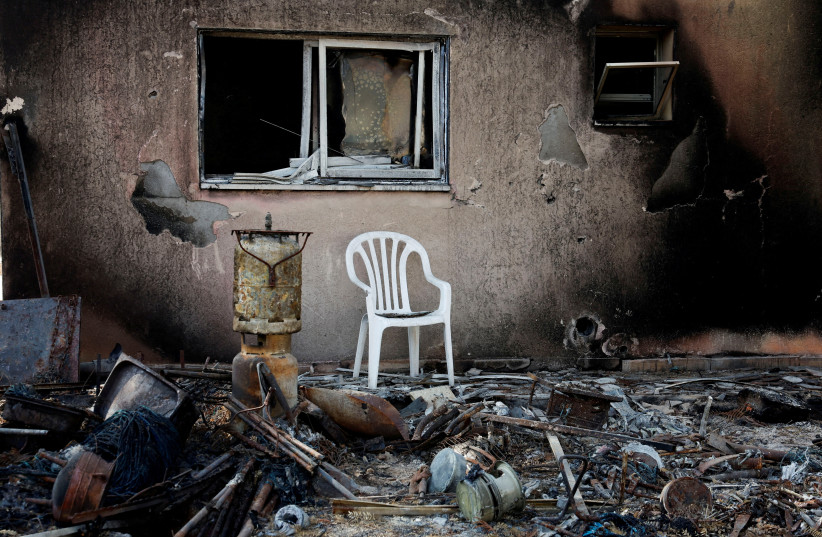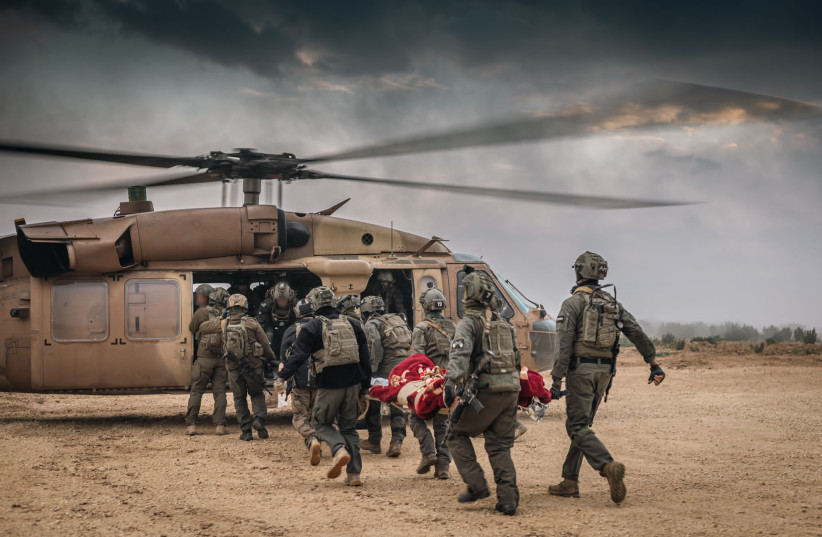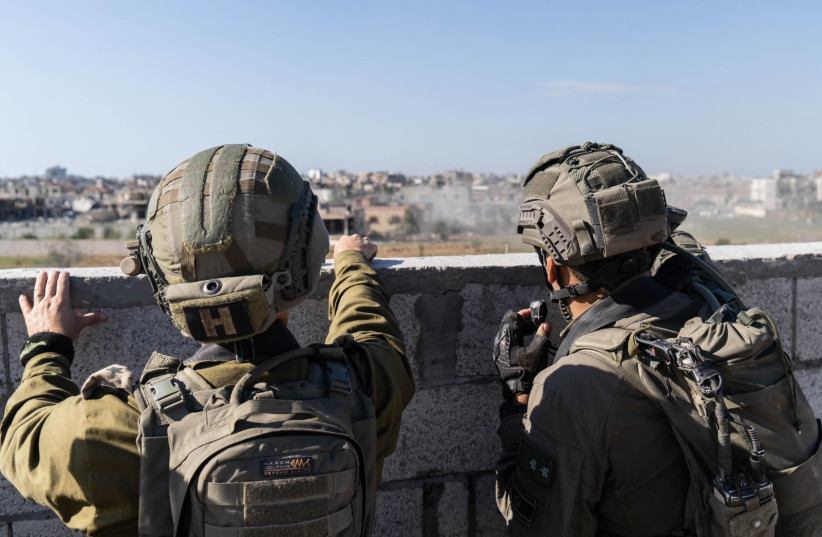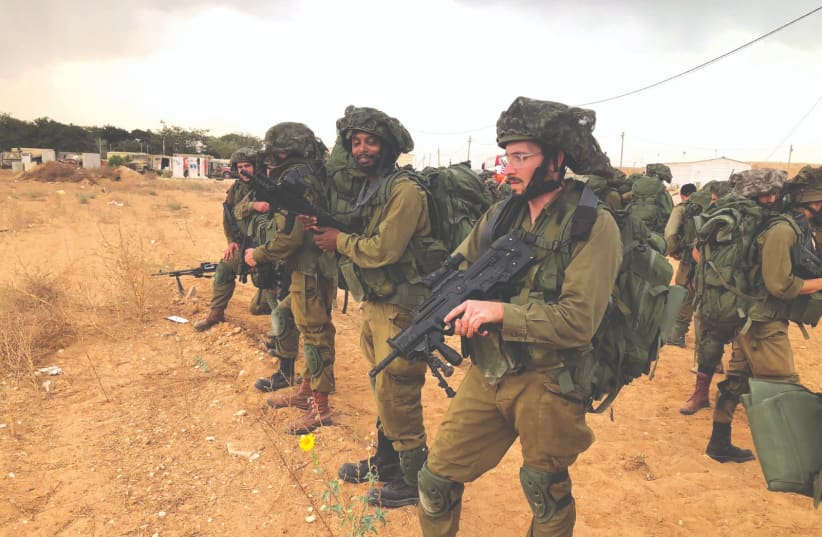If the infantryman has a defining responsibility, it is to march on. Even before mastering marksmanship, before learning tactics, the IDF infantryman learns to put one foot before the other, and to continue on with this simple task ad infinitum. Time and distance make even the simplest of tasks arduous, the lightest of weights into unbelievable burdens. The infantryman learns to march under the weight of time, his hope residing on the horizon. Every 5 kilometers is said to be the final stretch of the journey, though the destination always remains elusive. Each mountaintop is the final height, until the discovery that there are yet taller peaks still to climb.
When the members of my platoon first entered the October 7 war, we wrote down our bets for how long our reservist battalion would be serving. We hung the betting pool on the refrigerator in a house in Kissufim. Most guessed around 20 to 40 days; I was one of the closest, with 90. One hundred ten days – almost four months – later, Battalion 8111 has finally been released back to civilian life.
At times the weeks seemed to jet by, compressed into long days, but as we held a military ceremony last Sunday at Camp Nahshonim, it seemed like ages since we had first arrived there on October 7.
After news of the pogrom in the South broke, we had rushed to the storage armory to arm ourselves. There were no ceramic vests, the combat vests we received were old models, and we lacked equipment for specialists. We felt constant pressure from the images and stories of the massacre emerging, urging us to come as soon as possible. We thought we were headed straight into battle, then into the Gaza Strip. It was only after three days of preparation that we arrived in the area to help restore security.
We deployed to Kissufim, checking house by house for perpetrators of the pogrom. Most of the terrorists were already dead, rotting on the lawns of the town. The stench was almost as thick as the tension.


"There are terrorists still hiding here"
“There are terrorists still hiding here,” Imri, my platoon commander, would repeat, almost a mantra. He didn’t want us to let our guard down.
Eventually, we met the enemy. Imri was right; there had been a terrorist still hiding in the kibbutz, biding his time. He ambushed the Third Platoon, throwing two grenades at it when it searched a house on the edge of the town. One of the grenades rolled to the feet of the officer leading the charge, Capt. Eliya Yanovsky. He was blasted out of the house, but miraculously suffered no wounds. The medic David and the sergeant Shemesh were wounded by shrapnel. A soldier named Martin suffered catastrophic damage to his leg. Our company commander, Roey, and his radioman, Orr, continued the fight, pressing the attack and shooting the terrorist dead.
The incident didn’t end with the death of the terrorist. For Orr, Roey, and Eliya, the fight moved to an internal front. Orr jumped at sudden sounds, and Roey was even more quiet than usual. Eliya was troubled by reoccurring dreams of the grenade rolling toward him. He told few about these flashbacks. Despite being locked in inner battles, the three soldiers continued their operations in Kissufim.
Martin’s wounds were more apparent – his leg had to be amputated. Martin is one of the bravest men I know not just because he entered a building to fight a terrorist, but also because even after he lost his leg, he continued in his path. He continued to be in good spirits, to worry about his comrades, and to meet his new challenges head-on.
The company vowed not to forget his sacrifice, and carried on. We escorted our combat engineer partners as they defused the munitions left by terrorists across the village grounds. As the kibbutz was secured, electricity, water, and telecommunications were restored under our guard.
Then the mission changed, and we moved on to Re’im, near where the Supernova music festival massacre occurred. We continued to facilitate the return of life to the area. We guarded the residents as they buried their loved ones, as farmers began to return to the fields – without the foreign workers who had been brutally abducted by terrorists.
A site tainted by the stench of death
The pieces of Israel shattered in the tragedy weren’t always readily available to be restored; sometimes we had to look for them. We combed fields, valleys, and the remnants of the party site for dead bodies, weapons, and hiding enemies. The festival site was strewn with tents, clothing, drinks, personal belongings, all tainted by the stench of rot, of death.
Sometimes the searches seemed to be purposeless meanderings just to check boxes for a faceless high-ranking officer. There was skepticism toward a great many missions, as it seemed at times that elements of the military weren’t sure how to effectively use us. There was a sense of mistrust of the top brass who allowed the massacre to happen. While the scent of death hung close to massacre sites and battlefields, the miasma of uncertainty lingered on in us throughout the 100 days of service. We never knew when we would receive a new mission or base, when we would be sent for leave. Even with this frustration, we marched out into the wilderness between the kibbutzim and the Gaza border and staked out strategic points for infiltration.
From the field, we watched as the air force paved the way for a ground incursion, striking with helicopter gunships, warplanes, drones. Yet while the skies were ours, they also held danger. The unit was constantly cognizant of rockets, mortar bombs, suicide drones, and attack quadcopters. We grew accustomed to the unwelcome call of red alerts and shrieks of incoming projectiles, as well as the comforting hum of counterbattery fire flying overhead. Mortar teams fired around the clock, their steady thunder becoming a background noise.
As we participated in cross-border operations to prepare for the ground invasion, some of us grappled with the prospect that we wouldn’t be entering ourselves. The commander of the battalion indicated that our role would be limited to guarding the border and kibbutzim. Many were relieved – no one wanted to fall in battle and leave their families alone, but just as many had family members and friends who would be entering the Strip or were in the army. They felt that they needed to contribute, or to fight in their stead. For some the feeling that one could do more was ever present, that we had a responsibility to ensure October 7 would never happen again. We had to fight these insecurities, set them aside for our mission to secure the border as the incursion began.
We did our best to fill logistical gaps – the company secured ceramic plates, sniper rifles, rifle attachments, gloves, and cold-weather clothing.
Nahal Oz had been conquered by the enemy
Our mission changed again after three weeks of patrols, stakeouts, and border preparations. We transferred to Kfar Aza to secure the border, but also to oversee the rehabilitation of the key Nahal Oz base.
The base had been conquered by the enemy. When we arrived the bodies were gone, but rotten bits of gore remained undiscovered, flies swarmed bloodstains on the ground and floor, and the buildings remained torn to shreds by heavy fighting. The war room had been burned black. Rows of homes were similarly torched in Kfar Aza, where families were slaughtered or taken into captivity.
Our armaments continued to improve, with our light machine gunners receiving new Negevs, almost everyone getting new combat vests with ceramic plates.
Through rifle scopes and optics, we kept watch in Kfar Aza during nights of falling flares and blossoming explosions. The Gazan horizon glowed and billowed smoke.
Other days we stood solemn sentinels for civilian contractors who worked to make the Nahal Oz base livable.
We were the first company to man the outpost since the attack. It was rededicated by raising the Israeli flag and the singing of “Hatikvah.” With Nahal Oz refortified, the families of fallen soldiers were able to visit to see where their loved ones had fallen.


A ruthless battlefield, step after step after step
WE HELD Nahal Oz for only a week before we were told to pack up and prepare for redeployment. Rumors flew about the next assignment, but it soon became clear that we would be entering Gaza.
We underwent two days of preparation and training. We didn’t know what our mission was and what it would demand. Many of us packed as light as possible in anticipation of long marches; others had bags bursting to the seams with gear for any scenario. We waited at the staging ground in a forest near Kissufim. The hour of our entry was pushed back multiple times before we finally set off. “Hurry up and wait,” a medic named Amichai called it.
The entire war was accented by intense moments of action and tension, only to be followed by sudden and long periods of boredom and tediousness. These droughts of activity would in turn be abruptly broken, as our wait in the forest had been. When the command came down, we loaded our equipment onto our backs, and marched in two rows into Gaza. The Strip was silent, a silence interrupted only by the booming of our hearts and of distant explosions.
Our mission was to secure a vital logistics road which the Commando Brigade would use to enter Khan Yunis. After this, the road would continue to be a vital lifeline for food, ammunition, and other supplies.
The silence of our entry was short-lived. Almost as soon as we arrived, a mortar bomb fell next to our position. For the next month and a half we were subjected to the constant drum of drones, gunfire, and every munition imaginable.
There were no civilians; they had all evacuated, save for a man who came to our lines carrying a child. During interrogation he claimed to have been looking for food. He was suspected by some to be a Hamas spy, bringing a child as a shield because it was known that the sight of children stays our trigger finger. We sent him on his way with food, water, and a sleeping bag.
The area was a hive of Hamas operatives, honeycombed with tunnels. Every operation revealed more entrances, indicated more houses booby-trapped. The terrorists would fire RPGs at our forces, then quickly run for the safety of the tunnels. We began to eliminate the infrastructure used by the enemy near the road, pushing toward a tall school that dominated the area.
On December 10, the company searched a junction near the school. First Platoon discovered a house with Hamas uniforms, manuals, and flags. The battalion commander’s squad joined the company, discovering a tunnel entrance. No sooner had the shaft been spotted than an IED was set off, and Hamas operatives opened fire from the school.
Eliya was killed in the explosion, along with Roey’s radioman, St.-Sgt.-Maj. Ari Zenilman, and battalion command squad members Maj. Roman Bronshtein, Maj. Evyatar Cohen, and Warr. Ofc. Etay Perry. The battalion commander was wounded by shrapnel, along with another member of his squad. Roey was wounded in his leg and face, Orr in his foot and elbow. The platoon returned fire while extracting the dead and wounded to hospitals, and Assaf, the deputy company commander, took control of the unit. The command tank of the Anarchy armor company came crashing through the village, directing machine-gun fire and shells at the gunmen. At least five terrorists were killed in the battle.
The company returned to its outpost, but it would relive the moment forever.
The camp of cheap tents and nylon tarps had become a muddy mess in the heavy winter rain. With each step, we would become stuck. It was hard to get ourselves out of the muck. The air force dropping massive bombs on the school area didn’t offer catharsis, didn’t abate the anger at the battalion for how the operation was conducted. Some even grumbled about leaving.
One day we moved camps, and the sun set, painting the sky scarlet and bathing us in a tangerine glow. And we marched on.
There was only one way to fight an enemy that hid in tunnels every time we approached. In a three-day heavy operation, we forced all the terrorists in the area underground, identifying their tunnels as we maneuvered and filling them with explosives. We detonated the tunnels with the terrorists inside. Some survived from our operations, like the six burned and wounded operatives who surrendered to a neighboring unit, who related that 18 of their comrades remained smoldering corpses underground.
With Hamas cells in the area defeated, and changing IDF operations meaning the logistics road was no longer required, we relocated to Bani Suheila with a new company commander and a dozen new soldiers. Through “murder holes” carved into the walls of Palestinian homes that had been turned into outposts, we beheld the catastrophe that Hamas had willingly invited onto Gaza, a city destroyed. We watched over dig sites into the Hamas tunnels, barely sleeping during the long dark nights.


As abruptly as our service began, it ended
THEN, JUST as abruptly as our service began, it ended. We withdrew from Gaza, and stored our rifles and vests. We held ceremonies and psych sessions.
Yet the war is not over. There are still hostages, and Hamas still remains. For the wounded, physically and mentally, they take the war with them wherever they go. They will continue their fight, often silently, out of sight. For the rest of us, no doubt we will be called up again in the months to come, and we will again face the thunder of mortars, the tension from waiting, the grip of uncertainty, the march renewed. And march we will.
It seems a simple thing, to put one foot before the other and move forward. Yet the bravery of heroes like Martin, David, Shemesh, Roey, Orr, Eliya, and Ari isn’t just found in the great moments of firefights and explosions. It is also found in the quiet moments: the tired soldier who resolves to rise for his unending guard shifts; the one who takes on the next mission despite not having seen his family for a month; the one who carries the weight of unseen scars as he waits for the night to break into dawn. Courage is found in between the steps, in the decision to carry on.
And so the war continues, and so shall we. Back to civilian life, and when the time comes, we will don our uniforms again.
And so we shall march.
